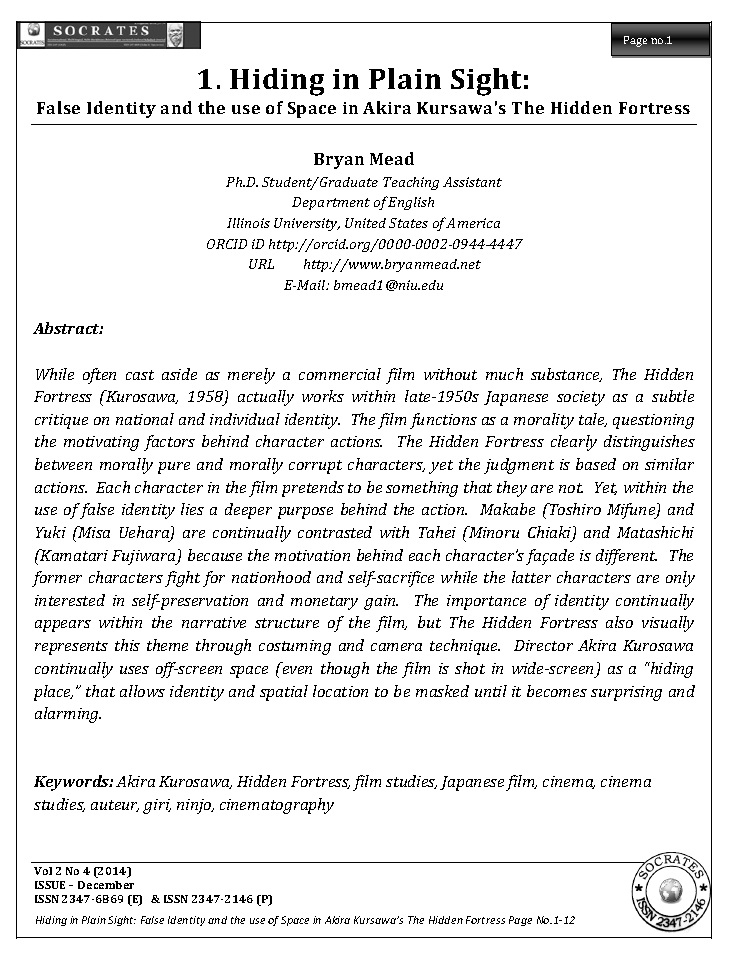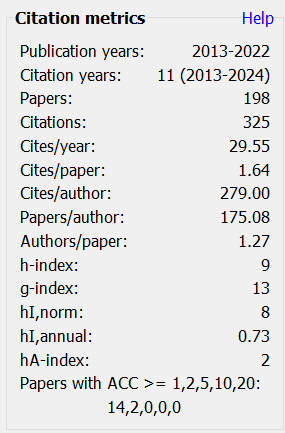Hiding in Plain Sight
False Identity and the use of Space in Akira Kursawa’s The Hidden Fortress
Keywords:
Akira Kurosawa, Hidden Fortress, film studies, Japanese film, cinema studies, auteur, giri, ninjo, cinematographyAbstract
While often cast aside as merely a commercial film without much substance, The Hidden Fortress (Kurosawa, 1958) actually works within late-1950s Japanese society as a subtle critique on national and individual identity. The film functions as a morality tale, questioning the motivating factors behind character actions. The Hidden Fortress clearly distinguishes between morally pure and morally corrupt characters, yet the judgment is based on similar actions. Each character in the film pretends to be something that they are not. Yet, within the use of false identity lies a deeper purpose behind the action. Makabe (Toshiro Mifune) and Yuki (Misa Uehara) are continually contrasted with Tahei (Minoru Chiaki) and Matashichi (Kamatari Fujiwara) because the motivation behind each character’s façade is different. The former characters fight for nationhood and self-sacrifice while the latter characters are only interested in self-preservation and monetary gain. The importance of identity continually appears within the narrative structure of the film, but The Hidden Fortress also visually represents this theme through costuming and camera technique. Director Akira Kurosawa continually uses off-screen space (even though the film is shot in wide-screen) as a “hiding place,” that allows identity and spatial location to be masked until it becomes surprising and alarming.
Downloads
Metrics
References
Chatman, S. (1990). Coming to terms: The rhetoric of narrative in fiction and film. Ithaca, NY: Cornell University Press.
Goodwin, J. (1994). Akira Kurosawa and intertextual cinema. Baltimore: Johns Hopkins University Press.
Howe, J. (2010). The Hidden Fortress. In J. Berra (Author), Directory of world cinema. (pp.90-91). Bristol (UK): Intellect.
Prince, S. (1999). The warrior's cinema: The cinema of Akira Kurosawa. Princeton, NJ:Princeton Univ. P.
Richie, D. (1996). The films of Akira Kurosawa,. Berkeley: University of California Press.
Russell, C. (1995). Narrative mortality: Death, closure, and new wave cinemas. Minneapolis:University of Minnesota Press.
West, D. (2006). Chasing dragons: An introduction to the martial arts film. London: I. B.Tauris.
Yoshimoto, M. (2000). Kurosawa: Film studies and Japanese cinema. Durham, NC: Duke University Press.

Downloads
Published
How to Cite
Issue
Section
License
Revised Copyright/CC license that applies to all the articles published after 05-02-2017
Attribution-NonCommercial 4.0 International (CC BY-NC 4.0)

Copyright/CC license that applies to all the articles published before 05-02-2017
Attribution-Non Commercial-No Derivatives 4.0 International (CC BY-NC-ND 4.0)

Author(s) will retain all the right except commercial and re-publishing rights. In the case of re-publishing, they will have to obtain written permission from the journal. Additional licensing agreements (Creative Commons licenses) grants rights to readers to copy, distribute, display and perform the work as long as you give the original author(s) credit, they can not use the works for commercial purposes and are not allowed to alter, transform, or build upon the work. For any reuse or distribution, readers and users must make clear to others the license terms of this work. Any of these conditions can be waived if you get permission from the copyright holders. Nothing in this license impairs or restricts the authors’ rights. To view a copy of this license, visit http://creativecommons.org/licenses/by-nc-nd/4.0/ or send a letter to Creative Commons, 171 Second Street, Suite 300, San Francisco, California, 94105, USA.
Research Papers published in SOCRATES are licensed under an Attribution-NonCommercial-NoDerivatives 4.0 International (CC BY-NC-ND 4.0)












